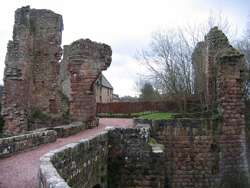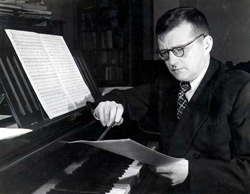The Rosslyn Code
Is a Scottish Da Vinci responsible for the Rosslyn melodies?
Gilbert Hay returned to his native Scotland in 1445 after 20 years on the court of King Charles VII of France—the same king who Joan of Arc helped install to the throne. Now, at age 48, Hay had a new assignment. William St. Clair, a wealthy Scottish lord, had commissioned Hay to translate three volumes on chivalry and warfare from French to Scots, a sort of half-brother to medieval English. Hay set up shop in the St. Clair family castle in the tiny town of Roslin, a few miles south of Edinburgh, and began work on what would become one of the first masterpieces of Scottish literature.
Just as Hay arrived in Roslin, St. Clair was embarking on a project of his own: a massive cathedral, which, by one later account, he wanted to erect as a thank-you note to God for all his good fortunes. (Others think he originally intended to build a university.) The first stone would be laid 10 years later, at a site just a short walk up the hill from the castle. St. Clair would only get one-fourth of his cathedral—the top fork of the intended crucifix-shaped floor plan—before money ran out. The result was Rosslyn Chapel, with all its splendorous figures and curious symbols.
Tommy and Stuart Mitchell believe the Rosslyn Motet—the piece of music Stuart composed based on the chapel's 213 stone carvings—is proof enough that there's a musical code embedded in the cathedral's walls. Nevertheless, the Mitchells cite Gilbert Hay's presence in Rosslyn as supplementary evidence. At some point during his worldwide travels, they conjecture, Hay learned about Chladni patterns and used them to create a musical code in the chapel that his patron was constructing. Without question, this is the part of the Mitchells' story for which there is scantest evidence.
Hay's education was certainly prodigious. He was among the first graduates of the University of St. Andrews, where he would have studied music as one of the classic disciplines, known as the trivium and the quadrivium. As the chamberlain to King Charles VII, he would have had access to the royal library as well as to the king's eclectic brother-in-law, René d'Anjou. René was a fellow poet and patron of the fine arts (as well as the titular King of Jerusalem). Both men had catholic interests: art, language, literature, governance, and history, to name a few. The St. Clair family moved in circles of people like Hay and d'Anjou. Whether the strange behavior of musical plates ever came up is impossible to say.

A few months after I returned home from Scotland, I called the cellist Yo-Yo Ma to get his take on the Rosslyn story. I had interviewed Ma a few years ago for a short profile, and recalled that his Silk Road Project has made him an expert on the thousands of musical instruments that have appeared and disappeared over the ages. I was happy to learn that he also knew a great deal about Chladni patterns—also known as "cymatics"— having seen violinmakers study the unique patterns that form on the board of the instrument as it's played.
Ma believes that Chladni patterns must have been discovered before the 18th century. Millennia ago, he points out, the Chinese had already mastered the art of the "singing bowl," a delicate bell made from a specific bronze alloy that could produce multiple tones at the same time. While there's no documentation that Chladni patterns were used to measure the correct ingredients for the metallurgy, Ma hypothesizes that the instruments' makers knew about the phenomenon. There's some evidence, for example, that Galileo noticed the effect while scraping a brass plate about 100 years after the Rosslyn Chapel was built. Whether this knowledge found its way to Hay, either through his travels or someone else's, will probably never be known. But history dangles the possibility just out of reach.
Even if Gilbert Hay knew of Chladni patterns, an overarching mystery remains: Why would he or anyone else go to so much trouble to conceal music in this obscure format? What would compel someone to carve a secret composition into the Rosslyn Chapel's walls?
Ma says he understands the impulse. "A composer is encoding some of the most intimate things he or she wants to say, and often can't say in a social setting," he says. As a performer, he explains, his "job is to try and do forensic musical analysis … to look at this encoding and say, well, who is this guy? What makes this important to him or her? What gives this meaning?"
When Ma talks about "forensic musical analysis," he means everything from seeking out explicit messages to hunting for what the composer wanted to communicate on purely musical terms. Composers do, on occasion, smuggle jokes and messages into their work. Johann Sebastian Bach liked to slip his initials into various motifs by using the sequence B-flat, A, C, B-natural, which is described in German notation as "B-A-C-H." Each variation of Edward Elgar's "Enigma Variations," likewise, is encoded with the initials or name of a friend. (The first movement contains repeated references to "CAE," his wife, Caroline Alice Elgar.) And, like Bach, Russian composer Dmitri Shostakovich frequently slipped a four-note sequence into his pieces that, when represented in the German notation, read "D, ES, C, H"—that is, "D. Sch."
The study of musical forensics, though, also requires a subtler unraveling of a composer's intent. Here, Dmitri Shostakovich is again instructive. The Soviet-era composer was perpetually in and out of favor with the Stalinists, and he frequently seeded his music with distaste for his nation's regime. Scholars quarrel over exactly where the composer's political feelings rested, but his work is riddled with sarcastic variations on patriotic marches, clamorous imitations of military exercises, and sorrowful eulogies for the motherland. Putting those sentiments in words would have been a death wish; concealing them in music provided him with protective coloration. (The camouflage wasn't perfect—the government banned his work on several occasions.)
The Mitchells are not arguing that a written message lurks inside the Rosslyn Code. Perhaps, like Shostakovich centuries later, Rosslyn's mystery composer felt the need to hide his musical impulses. Doing a bit of freelance composing in a house of God would not have sat well with the 15th-century Catholic Church. The angels and cubes could have been a way of hiding melodies in plain sight.
I prefer a different explanation. In the 1400s, it was impossible to know whether musical notation would still look the same in 100 years, much less 500. In the pre-light of the Renaissance, new cultural ideas were germinating across Europe and rapidly restructuring the arts. By using Chladni patterns—nature's musical notation rather than man's—a composer could ensure that future civilizations (or even an alien one) would be able to decode his notes.
Or maybe Rosslyn's secret sheet music was just a little inside joke among the chapel's designers. Stonemasons were always doing that—endowing an angel with the face of a favorite aunt, or a skeleton with the face of a mother-in-law. They didn't necessarily care if anyone ever made the connection. It was enough to leave a little part of oneself behind.

Mitchell originally experimented with combining melodies in counterpoint—two voices playing at the same time, complementing one another. His fascination with DNA gave him the idea that the melodies from crisscrossing arches might intertwine like a double helix. (This would be the second-most interesting DNA-related discovery to come out of Roslin: Dolly the sheep was cloned down the street.) The result, though, was cacophony, so he scrapped the idea in favor of a simpler one-melody-at-a-time approach.
Arranging and recombining music is a standard part of composition, and the role of the arranger varies widely. In an extreme case, a composer takes a simple theme and builds a whole new piece around it. One of Bach's most-popular works, his "Musical Offering," begins with a 21-note melody provided by King Frederick II of Prussia and grows into a piece that is unmistakably Bach's. At the opposite end of the spectrum, an arranger might take a complex piano piece—say, one of Franz Liszt's "Hungarian Rhapsodies"—and adapt it for an entire orchestra. Stuart Mitchell's composition, a four-part piece called the Rosslyn Motet, rests somewhere between these poles. The music is closely structured around the Rosslyn melodies, but the harmonizing voices and transitional melodies are his own.
"What he's given us is a basic melody to work with," Stuart said one night over dinner, alluding to Rosslyn's unidentified composer. We were eating at a restaurant called The Shore in upper Edinburgh, on the edge of the North Sea—a place he chose because it has a piano. "Some of the exercises I used to get in university and college were where you'd get about eight bars of Bach or Purcell, and underneath it was all blank. And you would add harmonies to this as Bach would have done or as Purcell would have done." Forming a listenable work out of the Rosslyn Code took a great deal of knowledge of musical history, but it was more technical than creative. You could think of it as Stuart taking an ancient strand of dinosaur DNA and mixing it with modern frog DNA to make a Stegosaurus.
Stuart Mitchell's Rosslyn Motet trades off between the instruments carved in stone in the chapel: lute, fiddle, organetto, bagpipes, and shawm (like an oboe). (The motet also includes several singers—a few of the angels are depicted singing from hymnals.) The melodies are difficult to categorize, but they generally resolve to a version of the A-minor scale. There are melodies that repeat the same note four or five times in a row and others that never resolve. The bagpipe line—one of the most moving melodies in the suite—ends on a D, which sounds tentative and incomplete until the next voice takes up the mantle. A G-sharp makes several guest appearances, giving parts of the piece the Halloween sound of a harmonic minor scale. Taken together, it's an elegantly structured sort of musical prayer, with each melody fitting neatly into an overarching voice that is solemn and arresting.
After dinner, we retired to the keyboard, where Stuart launched into an improvisation on the motet. He began soberly, running through the major themes. From there, his left hand propelled the piece into an extended blues solo over the Rosslyn chords, occasionally drifting back to motif. It was like "Fly Me to the Moon" in the hands of Oscar Peterson. From there he lands on "All the Things You Are," which later turned into the fantastically difficult first movement of Rachmaninoff's second piano concerto, followed by "Nice Work if You Can Get It"—an appropriate characterization of the Rosslyn composition, I think.
In his hands, the music of the cubes—whether an actual relic of the 15th century or an elaborate misreading of some wall decorations—sounds like the most natural thing in the world.
To hear piano renditions of five of Stuart Mitchell's melodies, click "Play Notes" on the interactive feature below. To hear the corresponding melody from Mitchell's finished product, "The Rosslyn Motet," click "Hear Motet." Mitchell took a few small liberties when arranging the melodies into a piece of chamber music. For example, he replaced the first note of the fourth melody with a B to match the opening notes of the first three melodies. He also replaced the last note of the fifth melody with a D, instead of an E, to lead more naturally into the next melody.






